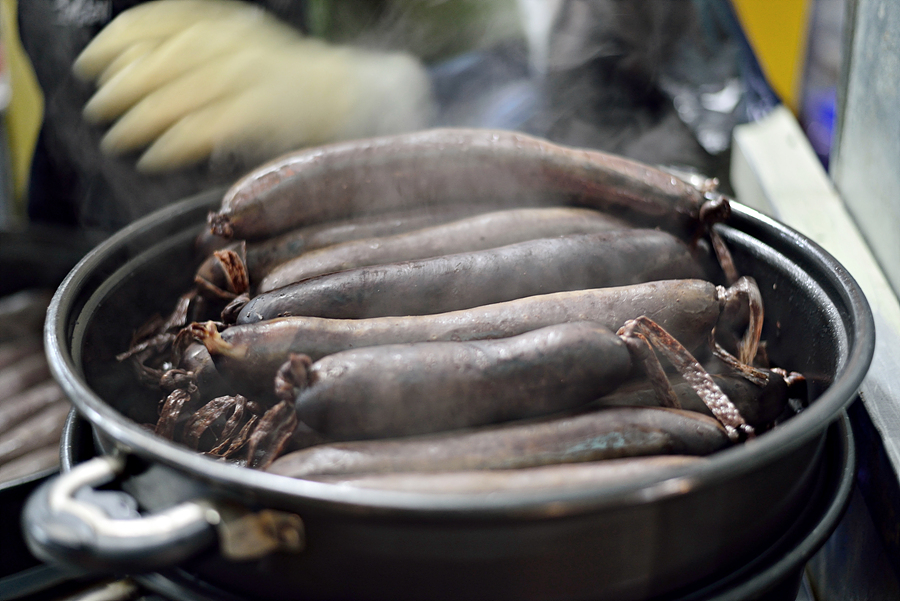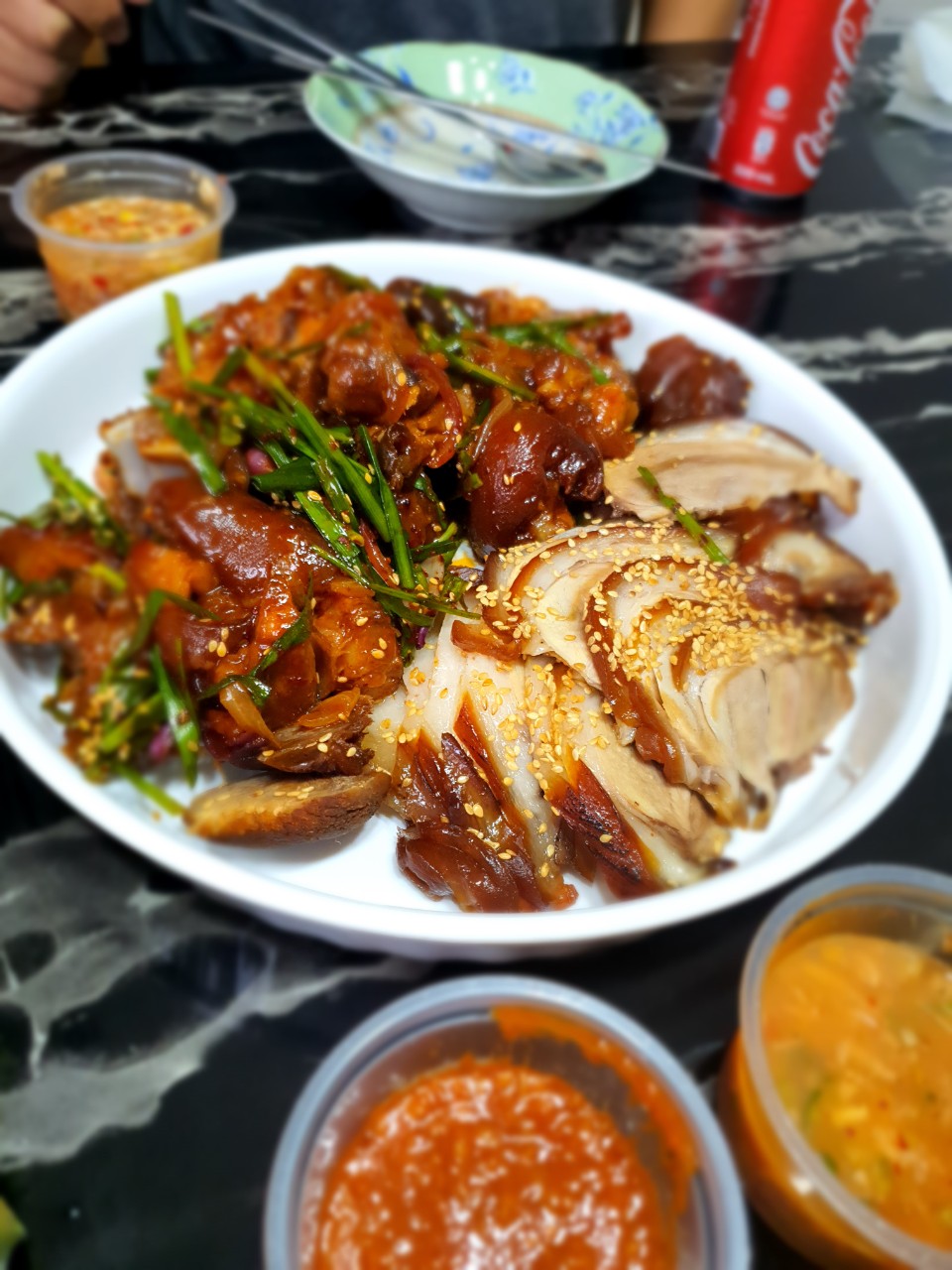|
Aekjeot
''Jeotgal'' () or ''jeot'' (), translated as salted seafood, is a category of salted preserved dishes made with seafood such as shrimps, oysters, clams, fish, and roe. Depending on the ingredients, ''jeotgal'' can range from flabby, solid pieces to clear, broth-like liquid. Solid ''jeotgal'' are usually eaten as ''banchan'' (side dishes). Liquid ''jeotgal'', called ''aekjeot'' () or fish sauce, is popularly used in kimchi seasoning, as well as in various soups and stews ('' guk'', ''jijimi'', ''jjigae''). As a condiment, jeotgal with smaller bits of solid ingredients such as ''saeu-jeot'' (shrimp ''jeotgal'') is commonly served as a dipping sauce with pork dishes (''bossam'', ''jokbal'', ''samgyeopsal''), ''sundae'' (Korean sausage), ''hoe'' (raw fish), and a number of soups and stews. History Fermented foods were widely available in Three Kingdoms of Korea, as ''Sānguózhì'', a Jin Chinese historical text published in 289, mentions that the Goguryeo Koreans are skilled in ... [...More Info...] [...Related Items...] OR: [Wikipedia] [Google] [Baidu] |
Kimchi
''Kimchi'' (; ko, 김치, gimchi, ), is a traditional Korean side dish of salted and fermented vegetables, such as napa cabbage and Korean radish. A wide selection of seasonings are used, including '' gochugaru'' (Korean chili powder), spring onions, garlic, ginger, and ''jeotgal'' (salted seafood), etc. Kimchi is also used in a variety of soups and stews. As a staple food in Korean cuisine, it is eaten as a side dish with almost every Korean meal. There are hundreds of different types of kimchi made with different vegetables as the main ingredients. Traditionally, winter kimchi, called kimjang, was stored in large earthenware fermentation vessels, called '' onggi'', in the ground to prevent freezing during the winter months and to keep it cool enough to slow down the fermentation process during summer months. The vessels are also kept outdoors in special terraces called jangdokdae. In contemporary times, household kimchi refrigerators are more commonly used. Etymol ... [...More Info...] [...Related Items...] OR: [Wikipedia] [Google] [Baidu] |
Jin Dynasty (265–420)
Jin is a toneless pinyin romanization of various Chinese names and words. These have also been romanized as Kin and Chin (Wade–Giles). "Jin" also occurs in Japanese and Korean. It may refer to: States Jìn 晉 * Jin (Chinese state) (晉國), major state of the Zhou dynasty, existing from the 11th century BC to 376 BC * Jin dynasty (266–420) (晉朝), also known as Liang Jin and Sima Jin * Jin (Later Tang precursor) (晉國; 907–923), Five Dynasties and Ten Kingdoms period * Later Jin (Five Dynasties) (後晉; 936–947), Five Dynasties and Ten Kingdoms period Jīn 金 * Jin dynasty (1115–1234) (金朝), also known as the Jurchen Jin * Later Jin (1616–1636) (後金; 1616–1636), precursor of the Qing dynasty Others * Jin (Korean state) (辰國), precursor of the Jinhan Confederation * Balhae (698–713), originally known as Jin (震) Places * Jin Prefecture (Shanxi) (晉州), a former Chinese prefecture centered on present-day Linfen, Shanxi * Jin Prefecture ... [...More Info...] [...Related Items...] OR: [Wikipedia] [Google] [Baidu] |
Sānguózhì
The ''Records or History of the Three Kingdoms'', also known by its Chinese name as the Sanguo Zhi, is a Chinese historical text which covers the history of the late Eastern Han dynasty (c. 184–220 AD) and the Three Kingdoms period (220–280 AD). It is widely regarded as the official and authoritative source historical text for that period. Written by Chen Shou in the third century, the work synthesizes the histories of the rival states of Cao Wei, Shu Han and Eastern Wu in the Three Kingdoms period into a single compiled text. The ''Records of the Three Kingdoms'' is the main source of influence for the 14th century historical novel ''Romance of the Three Kingdoms,'' considered one of the great four novels of Chinese classical literature. Major chunks of the records have been translated into English, but the tome has yet to be fully translated. Origin and structure The ''Records of the Grand Historian'', ''Book of Han'' and ''Book of the Later Han'', and the ''Recor ... [...More Info...] [...Related Items...] OR: [Wikipedia] [Google] [Baidu] |
Three Kingdoms Of Korea
Samhan or the Three Kingdoms of Korea () refers to the three kingdoms of Goguryeo (고구려, 高句麗), Baekje (백제, 百濟), and Silla (신라, 新羅). Goguryeo was later known as Goryeo (고려, 高麗), from which the modern name ''Korea'' is derived. The Three Kingdoms period is defined as being from 57 BC to 668 AD (but there existed Gaya confederacy in the southern region of the Korean Peninsula and relatively large states like Okjeo, Buyeo, and Dongye in its northern part and Manchuria of modern China). The "Korean Three Kingdoms" (Goguryeo, Baekje and Silla) contributed to what would become Korea; and the Goguryeo, Baekje and Silla peoples became what we know as the Korean people. The Book of Sui (Volume 81) recorded: "The customs, laws and clothes of Goguryeo, Baekje and Silla are generally identical." The three kingdoms occupied the entire peninsula of Korea and roughly half of Manchuria, located mostly in present-day China, along with smaller parts from prese ... [...More Info...] [...Related Items...] OR: [Wikipedia] [Google] [Baidu] |
Hoe (food)
''Hoe'' ( ) refers to several varieties of raw food dishes in Korean cuisine, consumed with local diversity by Koreans of all classes since the Three Kingdoms of Korea (57 BC - 668 AD), or earlier. Varieties There are uncooked ''hoe'' () as well as blanched ''sukhoe'' (). Raw ''Hoe'' (), the raw fish or meat dish, can be divided into ''saengseon-hoe'' (), filleted raw fish, and ''yukhoe'' (), sliced raw meat. ''Saengseon-hoe'' () can be either ''hwareo-hoe'' () made from freshly killed fish, or ''seoneo-hoe'' () made using aged fish. ''Mulhoe'' () is a cold raw fish soup. Blanched '' Sukhoe'' () is a blanched fish, seafood, meat, or vegetable dish. '' Ganghoe'' () is a dish of rolled and tied ribbons made with blanched vegetables such as water dropworts and scallions. Preparation ''Hwareo-hoe'' () is prepared by filleting freshly killed fish, while ''seoneo-hoe'' () is made with aged fish in a similar way as Japanese ''sashimi'': removing the blood and innards a ... [...More Info...] [...Related Items...] OR: [Wikipedia] [Google] [Baidu] |
Sundae (Korean Food)
''Sundae'' ( ko, 순대 , sometimes anglicized as ''soondae'') is a type of blood sausage in Korean cuisine. It is a popular street food in both North and South Korea, generally made by steaming cow or pig's intestines stuffed with various ingredients. History The ''sundae'' sausage dates back to the Goryeo period (918–1392), when wild boars, prominent across the Korean Peninsula, were used in the dish. Recipes for ''sundae'' are found in nineteenth century cookbooks including ''Gyuhap chongseo'' and '' Siuijeonseo''. Traditional ''sundae'', cow or pig intestines stuffed with '' seonji'' (blood), minced meats, rice, and vegetables, was an indulgent food consumed during special occasions, festivities and large family gatherings. After the Korean War, when meat was scarce during the period of post-war poverty, '' dangmyeon'' replaced meat fillings in South Korea. ''Sundae'' became an inexpensive street snack sold in '' bunsikjip'' (snack bars), '' pojangmacha'' (street stal ... [...More Info...] [...Related Items...] OR: [Wikipedia] [Google] [Baidu] |
Samgyeopsal
''Samgyeopsal'' (; ), ''samgyeopsal-gui'' ( ), or grilled pork belly is a type of ''gui'' (grilled dish) in Korean cuisine. Etymology Directly translated from Korean, ''samgyeop-sal'' () means "three layer flesh," referring to striations of lean meat and fat in the pork belly that appear as three layers when cut. It is the part of the abdomen under the loin from the 5th rib or 6th rib to the hind limb. In Korea, the word ''samgyeop-sal,'' meaning "pork belly", often refers to ''samgyeop-sal-gui'' (grilled pork belly), in the same way that the word ''galbi,'' meaning "ribs", often refers to ''galbi-gui'' (grilled beef ribs). ''Gui'' refers to roasted, baked, or grilled dishes. One can also find ''ogyeopsal'' (), with an ''o'' meaning "five" and "gyeop" meaning a layer. ''Ogyeop-sal'' includes the skin part of the pork belly, unlike ''samgyeop-sal'' where the skin is removed. History The first mention of the meat dish was in a ''Donga-ilbo'' article published on November 3 ... [...More Info...] [...Related Items...] OR: [Wikipedia] [Google] [Baidu] |
Jokbal
''Jokbal''(족발) is a Korean dish consisting of pig's trotters cooked with soy sauce and spices.Jokbal at It is usually braised in a combination of soy sauce, ginger, garlic, and rice wine. Additional ingredients used can include onion, leeks, garlic, cinnamon and black pepper. History Jokbal is presumed to have originated from braised pork, a local food of Hwanghae-do, where pigs' legs are boiled. The current jokbal is a food that started in Jangchung-dong in the 1960s, and is known to have been developed by grandmothers from Pyeongan-do and Hwanghae-do for a living. In the 1960s and 1970s, it began to be widely known through visitors ...[...More Info...] [...Related Items...] OR: [Wikipedia] [Google] [Baidu] |
Bossam
''Bossam'' (, 褓-) is a pork dish in Korean cuisine. It usually consists of pork shoulder that is boiled in spices and thinly sliced. The meat is served with side dishes such as spicy radish salad, sliced raw garlic, '' ssamjang'' (wrap sauce), ''saeu-jeot'' (salted shrimp), kimchi, and ''ssam'' (wrap) vegetables such as lettuce, '' kkaennip'' (perilla leaves), and inner leaves of a napa cabbage. ''Bossam'' is a popular dish in South Korea, often served as '' anju'' (i.e. food accompanying alcoholic drinks). To eat, the meat and side dishes are wrapped together in ''ssam'' vegetables, hence the literal meaning of ''bossam'': "wrapped" or "packaged". History ''Bossam'' is traditionally linked with the process of ''gimjang'', during which large quantities of kimchi are prepared for winters. To ensure the commitment of the workers during this labor-intensive process, ''yangban'' (scholar-gentry of the Joseon era) would deliver a pig for a feast. The workers would enjoy boiled pork ... [...More Info...] [...Related Items...] OR: [Wikipedia] [Google] [Baidu] |
Saeu-jeot
''Saeu-jeot'' * () is a variety of ''jeotgal'', salted and fermented food made with small shrimp in Korean cuisine. It is the most consumed ''jeotgal'' along with '' myeolchi-jeot'' (멸치젓, salted anchovy ''jeot'') in South Korea. The name consists of the two Korean words, ''saeu'' ( 새우 shrimp) and ''jeot''. ''Saeu-jeot'' is widely used throughout Korean cuisine but is mostly used as an ingredient in kimchi and dipping pastes. The shrimp used for making ''saeu-jeot'' are called ''jeot-saeu'' (젓새우) and are smaller and have thinner shells than ordinary shrimp. The quality of ''saeu-jeot'' largely depends on the freshness of the shrimp. In warm weather, fishermen may immediately add salt for preliminary preservation. Types The types of ''saeu-jeot'' depend on the kind of shrimp used and when they are harvested. In spring ''Putjeot'' (풋젓) is made with shrimp harvested from the end of January in lunar calendar through April. It is called ''deddeugi jeot'' (데� ... [...More Info...] [...Related Items...] OR: [Wikipedia] [Google] [Baidu] |
Condiment
A condiment is a preparation that is added to food, typically after cooking, to impart a specific flavor, to enhance the flavor, or to complement the dish. A table condiment or table sauce is more specifically a condiment that is served separately from the food and is added to taste by the diner. Condiments are sometimes added prior to serving, for example, in a sandwich made with ketchup, mustard or mayonnaise. Some condiments are used during cooking to add flavor or texture: barbecue sauce, compound butter, teriyaki sauce, soy sauce, Marmite and sour cream are examples. Many condiments, such as mustard or ketchup, are available in single-serving packets, commonly when supplied with take-out or fast food meals. Definition The exact definition of a condiment varies. Some definitions encompass spices and herbs, including salt and pepper, using the term interchangeably with ''seasoning''. Others restrict the definition to include only "prepared food compound containing ... [...More Info...] [...Related Items...] OR: [Wikipedia] [Google] [Baidu] |
.jpg)



.jpg)

